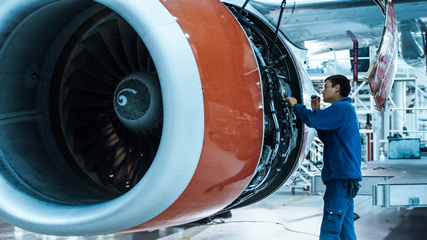[breadcrumb]
What is an Airplane and Aircraft Mechanic?
Airplane and aircraft mechanics perform repairs, preventative maintenance and routine maintenance on various types of aircraft, airplanes and helicopters. They maintain and repair the avionic and mechanical equipment that is necessary to operate aircraft safely.
They are certified by the Federal Aviation Administration to inspect, diagnose, repair and maintain the structural, mechanical and electronic components of the aircraft, including engines and hydraulic systems. This may include replacing parts, performing diagnostic devices and using tools to fix and assess aircraft. Many aircraft mechanics specialize in a specific type of aircraft.
They might work in hangars, repair stations or airfields.
How Can an Airplane and Aircraft Mechanic Get Mesothelioma by Occupational Exposure to Asbestos?
Asbestos was commonly used in commercial and military aircraft between 1930s and 1970s. Use was highest during World War II. Asbestos was contained in many aircraft components because it is fireproof, affordable and durable. Aircraft mechanics often change tires, brake pads and other parts that contained asbestos. Additionally, they work on electrical components that might have been insulated by insulation that contained asbestos. When the asbestos in these components is disturbed, microscopic asbestos fibers can become airborne and then inhaled or ingested by airplane and aircraft mechanics. These fibers then become embedded into the lung’s lining, which can later develop into mesothelioma. Aircraft mechanics were in constant contact with asbestos and usually took no precautions to protect against the possibility of breathing in this deadly toxin.
Aircraft mechanics today may continue to be exposed to asbestos if they work on aircraft manufactured before the 1980s that have asbestos-containing materials.
Locations in the United States for the Highest Employment Rates for Airplane and Aircraft Mechanics
According to the Bureau of Labor Statistics, the states with the highest employment rates for airplane and aircraft mechanics are:
Similar Occupations as Airplane and Aircraft Mechanics include:
- Aircraft and avionics equipment mechanics and technicians
- Aerospace engineering and operations technicians
- Automotive body and glass repairers
- Automotive service technicians and mechanics
- Electrical and electronics installers and repairers
- Electricians
- Electro-mechanical technicians
- Mechanical engineering technicians
Lawsuits and Settlements Involving Airplane and Aircraft Mechanics and Mesothelioma
A Florida jury returned a verdict of $9 million in 2016 to a woman who developed mesothelioma after being exposed to asbestos dust on her husband’s clothes. The husband worked for an aircraft manufacturer Northrop Grumman. The jury found in favor of the wife, finding the manufacturer responsible for the asbestos dust and her illness.
There have been other reported cases involving aircraft mechanics, but the final results of the cases are unpublished, so they may have resulted in confidential settlements.
Studies Related to Airplane and Aircraft Mechanics and Asbestos
A few studies have been completed connecting aircraft mechanic work and asbestos exposure, including:
- Aircraft maintenance and mesothelioma found that asbestos content that weighed between 16% and 23% were found in aircraft brakes in some situations
- https://www.ncbi.nlm.nih.gov/pmc/articles/PMC2923421/
- Airborne asbestos exposure during light aircraft brake replacement is a 2009 study that found that this activity did not demonstrate the presence of alarming levels of asbestos fibers
- https://www.ncbi.nlm.nih.gov/pubmed/19409949
Types of Asbestos Products Used by Airplane and Aircraft Mechanics
Asbestos was used in a variety of aircraft components. One of the primary uses of asbestos in aircraft was in brake pads, linings and shoes. Brakes involve high heat and friction and asbestos helped prevent their wear. Asbestos particles that were loosened by friction would accumulate in aircraft brake housings. When these housings were opened, the particles would become airborne.
When parts that contained asbestos would deteriorate, asbestos fibers would become dislodged and ingested by airplane and aircraft mechanics.
Asbestos was also contained in many other aircraft components, including the following:
- Engine and electrical insulation
- Asbestos blankets
- Cockpit heating systems
- Engine heat shields
- Engines
- Torque valves
- Gaskets
- Clutches
- Control valves
- Grommets for engines
- Electrical wiring and systems
- Insulation in cargo bays
- Adhesives, glues and epoxies to repair equipment
- Sealants
- Insulation for engine and exhaust systems
- Hydraulic service lines
- Flexible insulating tape
- Asbestos packing
- Asbestos tubing
- Refractory fiber felt
- Asbestos sheets
- Firewall seals and fabrics
- Foil insulating tape
- Firesleeves
- Body fillers
- Engine mounts
Manufacturers of Asbestos Products Used by Airplane and Aircraft Mechanics
Many asbestos companies were involved in the manufacture of asbestos products and knowingly exposed airplane and aircraft mechanics to asbestos. One such company was Johns Manville, which produced a variety of products that contained asbestos, including insulation to gaskets and cement adhesive. Bendix Corporation and Raybestos also manufactured asbestos products that could have exposed workers to asbestos. Northrop Grumman is a well-known aircraft manufacturer that has been named in asbestos suits.

